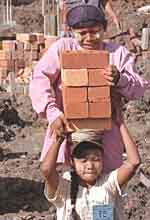Activity 4
Essential Question
- How can the quality of working conditions for children be improved in countries that still use child labor?
Background
In the early 21st century, child labor remains a serious problem in many parts of the world. Studies carried out in 1979, the International Year of the Child, show that more than 50 million children below the age of 15 were working in various jobs often under hazardous conditions. Many of these children live in underdeveloped countries in Latin America, Africa, and Asia. Their living conditions are crude and the chances for education minimal. The meager income they bring in, however, is necessary for the survival of their families. Frequently, these families lack the basic necessities of life- adequate food, decent clothing and shelter, and even water for bathing.

Bolivian children earn a meager living - edited from United Nations Website
Instructional Strategies
 |
Strategy 1 |
Mapping Children's Organizations in Asia
Read and discuss the following passage about the problem of child labor in the 21st century.
In some countries industrialization has created working conditions for children that rival the worst features of the 19th-century factories and mines. In India, for example some 20,000 children work 16-hour days in match factories.
Child labor problems are not, of course, limited to developing nations. They occur wherever poverty exists in Europe and the United States. The most important efforts to eliminate child labor abuses throughout the world come from the International Labor Organization (ILO) founded in 1919 and now a special agency of the United Nations. The organizations argues for:
- A minimum age of 16 years for admission to all work
- A higher minimum age for more dangerous jobs
- Compulsory medical examinations
- Regulation of night work
- Elimination of slavery and debt bondage and forced military service
Mapping Children's Organizations in Asia
- Visit a website which provides information about child labor in other parts of the world. For example: Children's Organizations in Asia
- Visit the Encarta mapping site or a similar one to locate the countries where these organizations exist.
- Continue your websearch by using the names of the countries as keywords to find more information about each of the countries you have located. Limit your research on these countries to: population, social conditions, health care, education, state of industrial development
- Analyze the demands from children in other parts of the world. For example consider the Child Workers' Petition.
Check for Understanding |
 Printable
Student View Printable
Student View |
- What are the similarities in living and working conditions between these countries and the living conditions in the United States in the 1800s?
- What other areas of the world would you predict might have similar concerns about child labor?
- What concerns about child labor seem to be universal?
- What is one major difference in the demands of children today as opposed to the demands from reformers in the United States during the 1800s?
 |
Strategy 2 |
Mapping Activity
Use your markable world map or use yarn to connect the United States to other parts of the world that students find are having concerns about child labor. Keep adding to these connections as students identify new areas of the world including areas in the United States where child labor is a concern. Talk about how we in the United States may think about how people in these areas of the world live? Ask them if our perceptions of other people are always accurate? Ask them how people of the world are connected, i.e., how buying an inexpensive pair of shoes may be the result of child labor in Asia? Refer to the unit questions on the board or the chart paper and discuss:
Check for Understanding |
 Printable
Student View Printable
Student View |
Have students write a paragraph on each of these questions for use in doing the performance assessment.
- Why are children in other countries of the world now being exposed to some of the same conditions that once existed in the United States?
- What can be done to improve the lives of children in these other countries?
 |
Strategy 3 |
Compare and Contrast
As students do their web searches, using a compare and contrast chart to record the information. Compare and contrast the information they are finding to conditions in the United States in the 1800s. For example, a simple compare and contrast chart may look like this:
 |
Strategy 4 |
Problem Solving
As students do their research, have them pay particular attention to the role of children around the world in advocating for improvements in the working conditions for children. Talk about why these organizations feel that it is important for children to be involved in the movement including:
- Children have ideas that are important and creative
- Children are directly involved in the problem
- Children have impacted progress in other areas of the world
- Children can develop their own potential and talents by being involved
- Children need to be heard
- Children need to build positive relationships with adults
- The collective efforts of children is a positive force for good
Talk about how children in the United States could help by being involved in helping children in other parts of the world. Make a list of what they might do as a class and as individuals to help improve working conditions for children in other parts of the world. Have them keep this list in their notebooks for use with the performance assessment.

 Module Menu
Module Menu Printable View
Printable View
 Scoring Guide
Scoring Guide